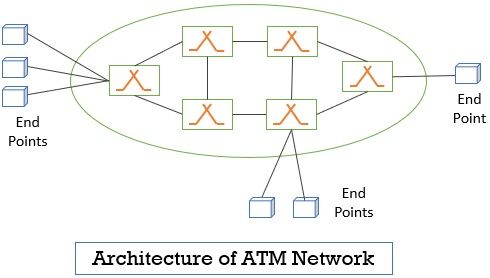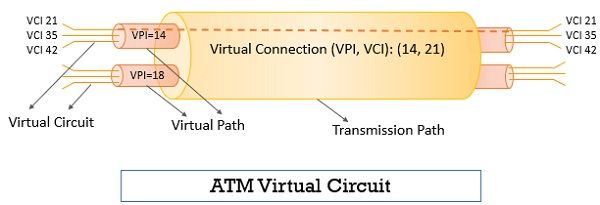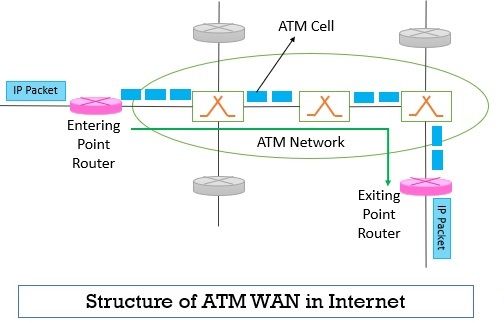IP over ATM is the transmission of IP datagram over a switched network such as ATM (Asynchronous Transfer Mode). In our few earlier contents, we have seen transmission of IP datagram over the connectionless LAN and point-to-point WAN that uses the available line to communicate.
In this section, we will discuss the transmission of IP datagram over the switched ATM WAN network which is a connection-oriented technology.
IP Over ATM
What is ATM?
Asynchronous transmission mode (ATM) is switched WAN and a connection-oriented technology where before a source computer can send data to the destination computer a connection has to be established. This connection is assigned an identifier during the transmission and when the transmission is over the connection is terminated.
There were six designing goals for the designer of ATM which are listed below:
- Minimize the use of transmission media with a higher transmission rate such as optical fiber.
- ATM technology must easily interface with the existing technology and system.
- ATM technology must also support the existing telecommunication hierarchies.
- The ATM technology must be implemented inexpensively.
- It should be a connection-oriented technology to ensure the exact delivery of the message.
- The ATM technology must transfer as many functions to hardware from software to gain more transmission speed.
ATM network is considered as a cell network as it uses cells as a basic unit of data transfer. Here you can compare cell in ATM with the frames we use in Ethernet i.e., the smallest unit used to exchange data over the network. The cell is the smallest and fixed-sized data unit used to exchange data in an ATM network.
At the source computer, the data to be transmitted is loaded into these identical cells. These cells are then multiplexed with the other cells and routed through the ATM network. ATM uses asynchronous time-division multiplexing to multiplex the cells coming from different links.
ATM Architecture
ATM is a switched WAN network and it uses switches to connect two communicating end devices in the network. The end devices are also referred to as endpoints in ATM networks. The switches in the network are connected to each other using a high-speed communication link.
As ATM is also a connection-oriented technology, so before an endpoint wants to send data to another endpoint a connection must be established. In an ATM network, a virtual connection is established between the endpoints. This virtual connection is established through the transmission path, virtual path, and virtual circuit.

The transmission path is a physical connection that connects an end system to a switch or two switches in the network. A transmission path is a set of virtual paths and each virtual path inside a transmission path is a set of virtual circuits.
To understand this easily consider the two connected switches as two cites and a transmission path connecting them as a set of all the highways that connect those two cities directly. Now as the transmission path is considered as a set of highways, every single highway is a virtual path and each particular lane in a highway is a virtual circuit.

In the figure above you can easily understand the structure of transmission path, virtual path, and virtual circuit. To identify the virtual connection the designer of ATM introduced a two-level identifier virtual path identifier (VPI) and virtual circuit identifier (VCI).
The VPI identifies a specific virtual path in the transmission path and VCI identifies a specific virtual circuit in the virtual path. All virtual circuits belonging to the same virtual path have the same VPI. To identify a virtual connection in an ATM network we require pair of identifiers (VPI, VCI).
In the ATM network, all the cells belonging to the same IP datagram follow the same virtual circuit and they also maintain their sequence till they reach the destination.
ATM Layers
The ATM standard defines three layers application adaption layer (AAL), ATM layer, and physical layer. The endpoints in ATM network uses all these three layers and switches inside the network using only physical and ATM layer.
Physical Layer
The physical layer specifies the kind of transmission medium used, provides a mechanism to transform the flow of cells into bits, and also provides a mechanism to transform electrical signals to optical for transmission.
ATM Layer
The ATM layer offers services such as routing cells from one endpoint of the ATM network to another endpoint, multiplexing cells from different channels, managing traffic over the network, and switching.
AAL Layer
The AAL layer provides an interface to the existing network. AAL layer accepts the data packets from different networks and maps them into ATM cells. This transmitted data can either be audio, video, data, or voice, and even each datatype may have a different transmission rate. At the receiver end, these cells are again reassembled into their original format.
There are four kinds of AAL layer but AAL5 is the most important AAL layer. It is also referred to as a simple and efficient adaption layer (SEAL). AAL5 is used to transmit IP packets on the Internet.
IP Over ATM
When the IP packet arrives at the router in the ATM network, the IP packet is encapsulated into the ATM cells. The number of ATM cells required to encapsulated an IP packet depends on the size of the IP packet and the size of cells in the ATM network.
To route these ATM cells through the ATM network a route is established between the two routers. We refer to these routers as the entry-point router and exit point router. The entry-point router is the one from where the IP packet enters the ATM network and the exit-point router is one from where the IP packet exits the router.

The IP packet arriving at the entry-point router has the IP address of source and destination. To route the cells from entry-point router to exit-point router, the ATM network requires three more addresses, IP and Physical address of entry-point and exit-point router and the virtual circuit identifier.
IP address: Every router connected to the ATM network has an IP address that defines that router in the IP layer. ATM network
Physical address: Every router connected to the ATM network also have a physical address. Each router in the ATM network is unique and is assigned by the network administrator. The physical address of the router in the ATM network is similar to the MAC address in LAN. The physical address defines the router in the ATM network.
Virtual Circuit Identifier (VCI): Virtual circuit identifier defines the connection between the entry-point router and exit point router. It is denoted by the pair of identifiers (VPI, VCI) as we have seen above.
Now let us discuss how to route the cell in the ATM network step by step.
Step 1: IP datagram (with source and destination IP address) reaches the entry-point router where it is encapsulated into ATM cells. Now the entry point router uses the destination IP address present in the IP datagram to identify the IP address of the next router.
The entry-point router uses its routing table to map the destination IP address to the IP address of the next router.
Step 2: Once the IP address of the next-hop router is identified the entry-point router uses ATMARP protocol to map the IP address of the next-hop router to its physical address.
Step 3: The virtual connection is bounded to the physical address of the entry-point router and exit point router. So, the physical address of the router is used to establish a virtual connection between endpoints in the ATM network.
This is how the IP datagram is routed over the switched ATM WAN network. We have also seen the similarities and differences when IP datagram is routed in LAN and point-to-point WAN and when it is routed in switched ATM WAN.

Leave a Reply